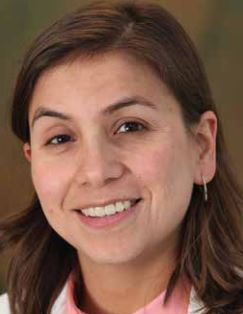Seeing Clearly
Dr. Maria Reinoso focuses on improving patients’ vision.
 As an ophthalmologist at the Louisiana State University Eye Center, specializing in retinal conditions and care, Dr. Maria Reinoso works to combat the effects of macular degeneration. This age-related eye disease negatively impacts patients’ vision — and therefore, their quality of life. “I feel sight is one of the most important senses,” says Dr. Reinoso, who followed her father into the field of ophthalmology.
As an ophthalmologist at the Louisiana State University Eye Center, specializing in retinal conditions and care, Dr. Maria Reinoso works to combat the effects of macular degeneration. This age-related eye disease negatively impacts patients’ vision — and therefore, their quality of life. “I feel sight is one of the most important senses,” says Dr. Reinoso, who followed her father into the field of ophthalmology.
Macular degeneration is a common condition of the eye, usually affecting patients 50 and older. It can run in families, and it occurs in women slightly more often than in men. “What the patient will see is either spots in their central vision or distorted vision — a blurry spot in the central part of the vision,” Dr. Reinoso explains. These distortions are caused by the accumulation of lipid, or fat, deposits at the back of the retina. “As we age, we start losing cells in the retina,” she says. “Those are the cells in charge of processing all the waste products, and that’s what accumulates back there.”
The disease appears in two forms: “dry” and “wet” macular degeneration. The dry form is most common, accounting for nearly 95 percent of diagnoses. “It usually progresses slowly and takes its time to affect central vision,” Dr. Reinoso says. As lipid deposits build between the retina and the network of blood vessels that supply it, the dry form of macular degeneration can progress into the wet form. “This is when the blood vessels in the back of the eye are leaking fluid into the retina,” she explains. “It progresses very rapidly and can affect the vision as soon as you get it.”
Treating Macular Degeneration
Though there is currently no cure for macular degeneration, several treatment options are available to slow the progression of the disease and ameliorate symptoms. Patients diagnosed with the disease’s dry form can take special supplements that include vitamins C and D, zinc, copper and lutein to slow the progression of the disease.
Treatment options for wet macular generation have progressed significantly within the last five years, says Dr. Reinoso. Several types of injections are now available to help decrease the amount of fluid at the back of the eye. “Basically, what they do is stop the production of the net of blood vessels by blocking the factor that makes them grow,” Dr. Reinoso says. Patients with advanced cases of the disease — for instance, those who only have vision in one eye — may also be candidates for surgery.
The Eye Center offers genetic testing to help predict whether a patient’s dry macular degeneration is likely to progress to the wet form. “We do want to watch it early — because the earlier we catch it, the better prognosis we have,” Dr. Reinoso says.
Patients diagnosed with macular degeneration are encouraged to increase their intake of leafy greens, which contain high concentrations of lutein. Smoking cessation is also pivotal in fighting the progress of macular degeneration. “Smoking can definitely make macular degeneration worse,” Dr. Reinoso says. “It can speed up the process of making dry worse, or cause dry to turn to wet.”
In addition to working with patients with macular degeneration, Dr. Reinoso treats conditions such as retinal detachment, complications from cataracts and even pulmonary hypertension, which can cause changes in the back of the eye.
DOCTOR INFO
Maria Reinoso, M.D.
Assistant Professor of Clinical Ophthalmology
LSU Eye Center
3700 St. Charles Ave.
(504) 412-1100
Combined Residency: Ochsner Clinic Foundation, Internal Medicine, 2005-2006 and Louisiana State University, Ophthalmology, 2006-2009
Board Certifications: Ophthalmology
Memberships: American Academy of Ophthalmology, American Society of Retina Specialists, New Orleans Academy of Ophthalmology
